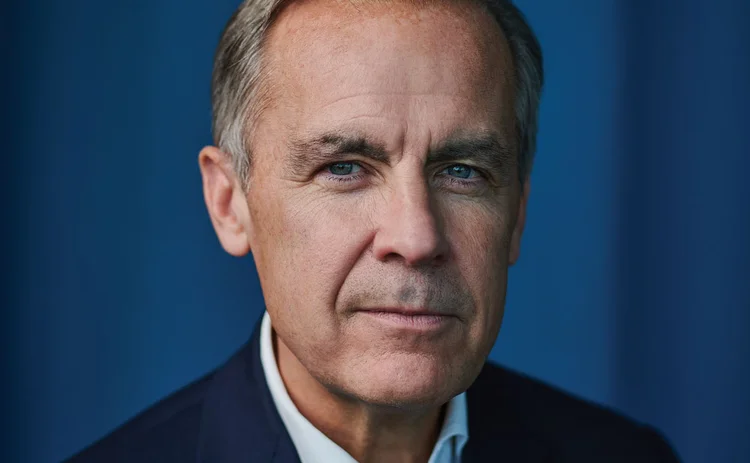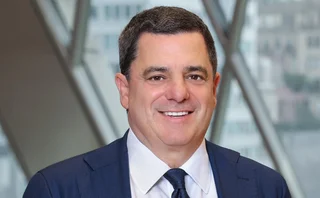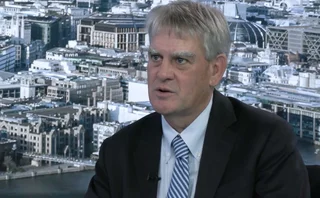
Lifetime achievement award: Mark Carney
Risk Awards 2022: The calm at the eye of the storm of post-crisis regulation and climate risk management

In December 2019, when the UN appointed Mark Carney as its special envoy for climate action and finance, they knew he was no stranger to handling conflict.
An adept and seasoned navigator of economic and political squalls, Carney has not been afraid to confront difficult issues head-on. He steered the Canadian financial system through the 2008 crisis as the head of its central bank, chaired the Financial Stability Board (FSB) for much of the task of rebuilding post-financial crisis regulation and led the Bank of England through the tumultuous times of both Brexit and the aftermath of the Libor-rigging scandal.
And it will surprise few to know that this year’s lifetime achievement award-winner, having personally helmed two central banks, is an advocate for their playing an active role in some of society’s biggest problems.
“The central bank is absolutely responsible for identifying systemic risks, taking appropriate actions to mitigate those or identifying actions that others can take in order to address them,” Carney tells Risk.net.
His approach has at times put him in the crosshairs of politicians and activists. On Carney’s watch, the BoE repeatedly warned about the potential economic impact of erecting new barriers to trade with Europe and about the uncertainty of what those barriers might be. It prompted criticism from some members of parliament, including one who accused him of being an “enemy of Brexit.”
Carney is unphased. He views his own actions as part of the job.
“[If you] look at the mandates of the central banks, they have these responsibilities,” he says. “Their commentary and action will be with respect to managing those risks, and in some cases, that is not the whole story, and therefore there is much broader political commentary around those stories than others.”
Climate risk is among the topics that can thrust regulators and central bankers to the centre of an intense political debate. Carney views this as inescapable, and points to the range of other issues – including housing, cyber risk and potential central bank digital currencies – which have “broader societal” implications, and which therefore involve both central bankers and finance ministers
His efforts as UN special envoy for climate action and finance – which included assembling the Glasgow Financial Alliance for Net Zero at Cop26 – were derided by some activists as greenwashing. But he takes the criticism in his stride.
The way in which Carney has dealt with the momentous problems he has had to confront over his career has won him the respect and admiration of peers and colleagues.
“His remarkable leadership was evident in the many contributions he made to the central bank community during his time as governor of two central banks,” says Agustin Carstens, the former Mexican central bank governor who has been general manager of the Bank for International Settlements since 2017. “He has always been highly regarded by his peers.”
Bradley Fried, who joined the court of directors of the BoE in May 2012 and became its chair in July 2018, is fulsome in his praise of how Carney transformed the thinking and the operations of one of the world’s oldest central banks. He did so whilst also assuming widening regulatory responsibilities, exemplified in the creation of the financial policy committee in 2013 to work alongside the traditional role of the monetary policy committee.
“Mark changed this institution profoundly, exploiting the synergies of having monetary policy, macroeconomic policy and microprudential regulation together in one institution,” says Fried. “In so doing, he combined the best of the Bank’s traditions with innovations that prepared it to face the future.”
Public sector path
In fact, Carney’s public sector problem-solving started during his early career at Goldman Sachs. It was his interest in a public sector career that drove him towards a degree and a doctorate in economics, he tells Risk.net. Having begun his time at Goldman working in credit risk, he was naturally drawn to the bank’s sovereign team becoming its co-head and later head of emerging market debt capital.
There were highs – helping governments in Egypt, South Africa and South Korea, along with Qatar’s government-backed gas projects, to gain access to global capital markets – and there were lows. Sovereign defaults in Russia and Argentina left lasting impressions on Carney, as did the occasionally negative effects of global capital influx: “[It] brings investment, but also correlated risks, and in many cases amplifies the risks that are there,” says Carney. These developments would inform his subsequent public policy work on micro and in turn macro reforms.
He moved to the public sector in 2003, mere months after the Argentine crisis, when he joined the Bank of Canada as deputy governor. After a year, he left for the Canadian finance ministry before returning to the Bank of Canada as governor in February 2008 – just as the global financial crisis was erupting.
In some ways, says Carney, Canada was “fortunate” to have been affected early by the crisis. The freezing of the local asset-backed commercial paper (ABCP) market in late 2007 provided the context for a 50 basis point rate cut announced in March 2008, straight after he had taken up the governorship. The European Central Bank (ECB) meanwhile was still raising rates as late as July of that year.
The Canadian authorities found that around C$20 billion of ABCP was supporting a credit stack that had over C$220 billion of leveraged super senior tranches rated triple-A, Carney notes, and a larger stack of C$600 billion in total.

“We realised, if that was going on in a sleepy corner of global markets in Canada, imagine what’s going on elsewhere,” says Carney. “With the [structured investment vehicles] and the amount of leverage and embedded leverage in the system.”
It was a major turning point.
“From that point onwards, we had a feeling that this was going to be very difficult,” he says. His appreciation of the scale of what could unfold, and the importance of an orderly resolution, gave Carney an insight into “the likely need for very large central bank actions”.
Having worked as part of Canada’s G7 team during his time at the finance ministry, however, he was also aware of the enormous challenge of striking a deal among the developed nations.
On October 8, 2008, major central banks staged a co-ordinated 50bp rate cut to try to re-inject liquidity into frozen markets. No-one thought it was the whole answer. To some extent it was a stopgap until a meeting of the G7 that weekend could put in place a broader solution.
“At the time that the cut was made, a lot of decisions still needed to be taken by the major [national] treasuries in order for that to happen, so we didn’t know for sure that it was going to work,” says Carney.
Introducing bail-in
Greater unanimity emerged post-crisis, when the regulatory community came to the strong consensus that banks needed to hold significantly more capital. This set the stage for much of the Basel Committee on Banking Supervision’s Basel III rulemaking, in which Carney would participate as a member of Basel’s governors and heads of supervision committee, and from 2011 to 2018 as chair of the FSB.
“Mark played a central co-ordinating role in building a more resilient financial system in the wake of the great financial crisis,” says Carstens.
The FSB produced the term sheet for total loss-absorbing capacity (TLAC), which includes both equity and a layer of debt that can be converted into equity if a bank gets into distress.
This cornerstone concept of the so-called bail-in was inspired by the ideas of an earlier lifetime achievement award winner, Wilson Ervin.
The FSB’s translation of this idea into formal regulation was one of the key elements designed to avoid the “too-big-to-fail” dilemma that had forced taxpayer-funded bank bailouts, such as the UK government’s rescue of RBS in 2008.
In 2020, when the bail-in concept was reviewed by the FSB, however, some investors expressed scepticism that the tool would ever be used for a systemic bank – a sentiment driven partly by the fact that, even as the implementation of TLAC began, national governments were still bailing out banks that were not even globally systemic.
I would say that on the capital framework, things can always be improved, but it is holding up reasonably well
Mark Carney
Carney remains a supporter, and says the vital element is ensuring investor suitability. Specifically, in the past, some European banks sold bonds eligible for bail-in to retail investors, which contributed to the political reluctance of national governments to allow resolution of these banks.
“Large [institutional investors], with full disclosure and full understanding, have bought these instruments and enjoyed higher returns,” says Carney. “Are those large and in many respects well-off institutions going to be subsidised by the taxpayer and not [have the bank debt they hold] bailed in? I don’t think that’s credible.”
“Where it gets murky is if those large institutions are mixed in with a very large number of retail investors,” he adds. “And then the politics shifts, which is why it’s important that the conduct authorities are clear about who can own the instruments.”
Carney praises regulators like the UK Financial Conduct Authority that have taken the initiative to restrict the sale of TLAC-eligible instruments.
He also believes the adoption of countercyclical capital buffers that can be run down during stress periods – something the BoE and other European regulators authorised during the Covid pandemic – have helped provide more headroom.
“I would say that on the capital framework, things can always be improved, but it is holding up reasonably well,” says Carney. “There’s a fair bit of evidence – at least in my judgement – that the incentives are better aligned, that there’s a greater responsibility, better risk management.”
Liquidity balancing act
Unlike the increase in capital buffers, the question of how far banks should self-insure their liquidity positions is more hotly contested. Regulators introduced tough new liquidity standards, including the liquidity coverage ratio (LCR) and net stable funding ratio, both of which were finalised while Carney was at the BoE. At the same time, however, some central banks, including the BoE and the ECB, set up a range of permanent liquidity facilities to underpin market functioning.
The US Federal Reserve has been slower to move down this route, officially launching a standing repo facility only in mid-2021, amidst repeated concerns that automatic access to central bank liquidity creates moral hazard – a disincentive for banks to manage their own liquidity risks properly. In its absence, however, the Fed was obliged to open a set of emergency facilities at the height of Covid-induced volatility in March and April 2020.
For Carney, there is a vital difference of purpose between capital and liquidity ratios: while capital is a minimum level below which banks are not allowed to fall, liquidity is supposed to be a buffer for use in times of funding stress. He believes this makes central bank liquidity “integral” to the system, and that it should be available on a consistent basis, not just in times of stress.
“If [liquidity ratios] become hard floors, then you’ve just shifted where the liquidity problem starts, as opposed to actually having liquidity that is usable,” says Carney. “I would say that absent widespread access to central bank liquidity with a broad range of collateral – appropriately haircut and risk-managed by the central bank – the LCR becomes a hard floor.”
He acknowledges that “the ability and willingness of banks to redistribute liquidity in times of stress throughout the system has diminished, perhaps in part because of the interaction with liquidity rules.” As a result, central banks have had to modify liquidity facilities or engage in outright purchases, such as during the first weeks of the Covid pandemic in 2020.
“On the liquidity side, there have been some improvements, but I am not sure from a systemic perspective it is where it needs to be, and it needs to be thought of very much more holistically,” says Carney.
The overall framework is a “work in progress,” he says.
Greater capital and liquidity requirements brought with them greater demands on cross-border co-ordination between regulators. Carney says the political pressures flowing from the famous maxim of his BoE predecessor Mervyn King – that banks may be global in life, but are always national in death – has resulted in tensions between home and host supervisors. Host authorities may want banks to build up significant resources in their subsidiaries, but this potentially makes global banks less resilient.

Carney says ring-fencing liquidity increases risk in the system as a whole, leading to trapped liquidity and meaning that “liquidity is no longer the sum of its parts”.
The TLAC standard included the concept of prepositioning – placing bail-in debt and equity into significant subsidiaries ex ante, so that it is readily available if that subsidiary becomes distressed. The FSB proposed a range of prepositioning, from 75% of what the entity’s standalone TLAC requirement would be, up to 90%.
Carney’s own preference was to maintain cross-border fungibility of liquidity and capital as far as prudently possible to help global banking groups manage risks better wherever they arise. While many major host regulators opted for the maximum 90% TLAC prepositioning, the BoE went for 75% to allow more flexibility, absent specific reasons to raise the requirement for individual UK subsidiaries.
“If you are at the lower end of that range, you have a more efficient capital structure, you have more unencumbered TLAC at the parent that then can be flowed down to the relevant jurisdiction if needed,” says Carney. “The UK, I think to its credit, went to the lower end of that range, consistent with having an open financial system.”
As the rules for bank balance sheets were tightened post-crisis, new risks emerged – especially in the asset management sector. The FSB moved quickly under Carney’s leadership to propose new standards for fixed net asset value money market funds (MMFs), but consensus on how to approach other buy-side firms such as hedge funds has been more elusive.
Carney does not take the view that risk simply migrates from one institution to another. Instead, he emphasises: “The riskiness of an asset depends on who holds it, and the ability of the institution to manage the liquidity risk and – if it wishes – to hold the asset through shocks and disturbances.”
For this reason, he views entities like MMFs and the Chinese wealth management products sector as particular priorities, given the potential liquidity mismatch between assets and liabilities. He says the Chinese authorities have already made substantial headway on winding down credit and maturity transformation that takes place “without the safety net” of the banking system. By contrast, he thinks the “largely American” issue with MMFs “was not adequately addressed” after 2008.
“We saw that with events of 2020, so there’s more to be done there, and it just shows the limits to which that structure can be used,” says Carney.
As an aside, he shares the view of some current regulators like the Fed’s Lael Brainard that stablecoins are essentially unregulated MMFs, which pose a particular risk because of their use as a payment tool.
Carney also believes funds that offer daily redemptions while investing in relatively illiquid assets such as leveraged loans or emerging market corporate debt should face greater scrutiny.
“There is still this representation to the individual that [the fund] has risk, but it’s equivalent basically to a bank deposit – you can get your money quickly. That is of a scale that I think approaches a systemic risk, and this is what the FSB has been looking at.”
Changing the financial climate
Among global regulators, Carney was notably on the front foot on the question of incentivising the financial sector to reduce financing of carbon emissions and prepare for the risks caused by the physical effects of climate change. As he was on the impact of policy changes to tackle it.
“Globally, his huge personal investment in galvanising thought and action on climate change within the financial sector had significant returns, most recently attested to at [the] Cop26 [summit] in Glasgow,” says Fried.
Carney says his thinking was influenced by his experience at the BoE of regulating the huge Lloyds reinsurance market and the “direct line of sight” into the catastrophe risks incurred.
“One of our core responsibilities – and those institutions’ responsibilities – was to really be constantly updating their risk models, their underwriting standards, their coverage, to manage that,” says Carney. “You look at that, and you realise: these are big risks moving in a nonlinear way, and this is really just getting going.”
In addition, he credits the French presidency of Cop21 in Paris for asking the FSB to look at the systemic risks stemming from climate change. This also led to the development of the Task Force on Climate-Related Disclosures, which Carney co-founded with Michael Bloomberg.
When you look back at what we were doing three, four years ago on climate risk it’s quite primitive. It will be the same thing five years from now, when we look back at where we are today
Mark Carney
At first, he says, the focus was on physical risks, but over time, it became clear that transition risks also had systemic implications that could not be ignored. Financial sector attention to potentially stranded assets and business models has now become “mainstream,” he adds.
“The challenge for financial institutions is to figure out where those risks lie, and ideally first and foremost, to help their clients make the investments so their business models aren’t stranded,” says Carney. “So their clients are carbon-competitive. But, if not, to manage down those positions, so that they don’t face those associated losses.”
Cop26 occasioned some strong criticism from non-governmental organisations that claimed the Glasgow Financial Alliance for Net Zero that Carney was helping to convene was in reality “watering down” commitments to net-zero carbon emissions financing. Campaigners pointed out that Brookfield, the asset manager where Carney is now head of transition financing, also invests in oil sands extraction and gas pipelines.
Concerns around so-called greenwashing to evade genuine emissions reduction are longstanding, and Carney acknowledges the financial sector’s work is a “process”.
“When you look back at what we were doing three, four years ago on climate risk it’s quite primitive. It will be the same thing five years from now, when we look back at where we are today, even though it’s moved quite substantially,” he says
He believes private sector initiatives can work hand-in-hand with public policy changes in a way that is “mutually reinforcing.” As policymakers seek to drive emissions reduction, the financial sector will see more value in assets that are managed towards net-zero and will therefore provide extra funding for them, which will in turn make the gradual tightening of policy easier to undertake. He says if reducing emissions is not the top strategic priority for all executives, it is certainly in the top three for most.
“In the extremes on the energy side, [the difference in] cost of capital ratios between lowest and highest carbon, it’s multiples of four or five times. In European equities, if you look at steel, building materials, transportation and others, there are clear valuation premiums for those that are making more progress and have the prospect of making more progress towards lower emissions,” he says.
As he was at the start of his career, Carney is once again at the intersection of private finance and public policy. And as with his experience of Brexit at the BoE, is at the nexus of an intense political debate.
Libor legacy
The response to the manipulation of Libor and other benchmark rates was a test of Carney’s mettle and his diplomacy. Senior executives at Barclays had provided evidence in parliamentary testimony that they had discussed Libor rate submissions with then deputy governor Paul Tucker during 2008, drawing the central bank deeper into the scandal.
Carney is tactful about the situation at the BoE and the implications of Libor for the regulator, but he is clear about how far-reaching the rethink needed to be.
“It was very much an issue of both systemic risk and conduct risk on a level that had some systemic implications,” he says. “Libor manipulation in parallel with the manipulation of FX benchmarks and others were causes for concern in terms of culture and institutions.”
At first, the approach to Libor at the FSB level was to offer regulators a choice of reforming or replacing benchmark indexes. Carney says the BoE’s initial priority was to stabilise the market – at a time when many Libor panel members wanted to jump ship to avoid incurring legal risk- and then to pursue a “deliberate process” of reform. He quickly concluded this stance would be inadequate.
“My personal view was that just wasn’t going to happen, because if you looked at the system as a whole, there was unlikely to be a resurgence of this short-term, large, wholesale interbank lending market – and if there was, we might have other problems with liquidity and systemic risks, and why would you want that?” he says. “For systemic reasons you couldn’t have permanently a market that was based on expert judgement when the expertise was based farther and farther in the past, so I did feel that ultimately it was going to need to be not just reformed but replaced.”
In 2017, when Carney was still BoE governor, Andrew Bailey, who would succeed him in the role but was then head of the FCA, revealed in a bombshell speech that banks contributing to Libor had agreed to continue doing so voluntarily until the end of 2021, and that they would be free to cut and run after that, setting the ball in motion for Libor’s eventual phase-out at the end of last year.
Brexit battle
The 2016 Brexit vote to take the UK out of the single European market was one major development beyond Carney’s control. His warnings about the economic impact of leaving the union went effectively unheeded in the referendum and earned him partisan criticism.
In reality, Carney has been consistent in his support for well-integrated global financial markets as the best means to make the financial system more resilient –and critical of jurisdictions that deliberately impede them. Which includes the European Union.
In particular, BoE officials have been locked in an ongoing debate with the ECB, which hopes to see the clearing of euro-denominated derivatives relocated into the EU. The UK operations of LCH currently account for a sizeable majority of the euro clearing business. For Carney, a strict clearing location policy runs counter to good risk management.
“You absolutely have economies of scale and scope in collateral and central clearing, and the ring-fencing or repatriation of certain transactions in that regard can actually increase substantially the risk in the system because you lose some of those benefits and you have much more correlated risk,” says Carney.
During his time at the Bank of Canada, he says they viewed the clearing of Canadian dollar instruments in London as a positive sign, especially after the experience of the 2007-2008 crisis.
“When we thought about reducing liquidity risk in Canadian repo and other markets, we felt it made more sense for the Canadian derivatives markets to be pooled in London and to get the broader benefits of that, than to have a narrow pool of concentrated Canadian counterparties with concentrated Canadian collateral in concentrated Canadian derivatives. In retrospect, I think that decision has proved itself,” he adds.
Only users who have a paid subscription or are part of a corporate subscription are able to print or copy content.
To access these options, along with all other subscription benefits, please contact info@risk.net or view our subscription options here: http://subscriptions.risk.net/subscribe
You are currently unable to print this content. Please contact info@risk.net to find out more.
You are currently unable to copy this content. Please contact info@risk.net to find out more.
Copyright Infopro Digital Limited. All rights reserved.
As outlined in our terms and conditions, https://www.infopro-digital.com/terms-and-conditions/subscriptions/ (point 2.4), printing is limited to a single copy.
If you would like to purchase additional rights please email info@risk.net
Copyright Infopro Digital Limited. All rights reserved.
You may share this content using our article tools. As outlined in our terms and conditions, https://www.infopro-digital.com/terms-and-conditions/subscriptions/ (clause 2.4), an Authorised User may only make one copy of the materials for their own personal use. You must also comply with the restrictions in clause 2.5.
If you would like to purchase additional rights please email info@risk.net
More on Awards
Collateral management and optimisation product of the year: CloudMargin
Delivering the modern blueprint for enterprise collateral resilience
Flow market-maker of the year: Citadel Securities
Risk Awards 2026: No financing; no long-dated swaps? “No distractions,” says Esposito
Pricing and analytics: fixed income – Quantifi
Quantifi delivers high-performance, transparent and adaptable pricing and risk analytics for fixed income and credit markets
Derivatives house of the year: Citi
Risk Awards 2026: Rev up, RWAs down, as US bank gets back on track (with added XiNG and XiP)
Technology vendor of the year: SS&C Algorithmics
Risk Awards 2026: From cloud, to chips, to maths tricks – vendor getting more out of existing tech
SS&C Algorithmics: winner’s interview with Curt Burmeister
SS&C Algorithmics wins three categories in this year’s Markets Technology Awards in addition to Technology vendor of the year at the Risk Awards
Best vendor for system support and implementation: Murex
Murex wins Best vendor for system support and implementation at the Markets Technology Awards 2026
Pricing and analytics: cross-asset and structured – Murex
Murex wins Pricing and analytics: cross-asset and structured at the Markets Technology Awards 2026 thanks to its MX.3 platform







